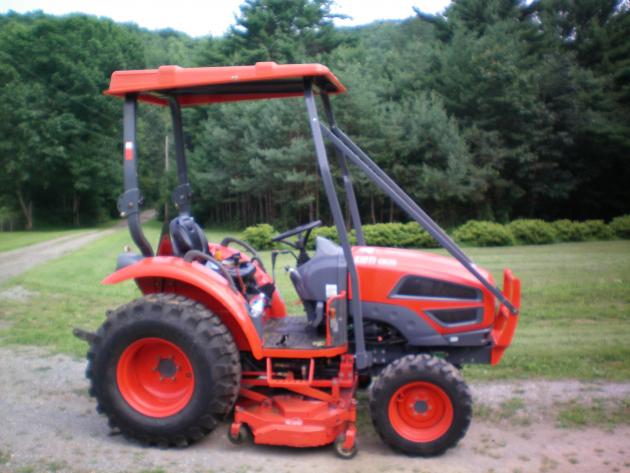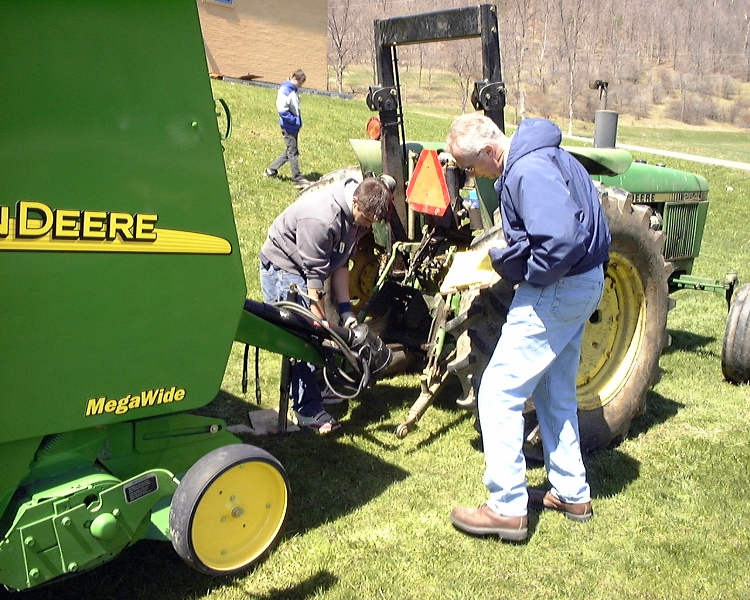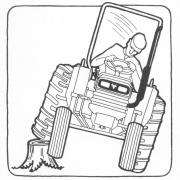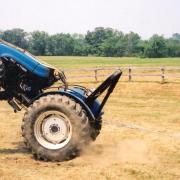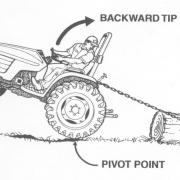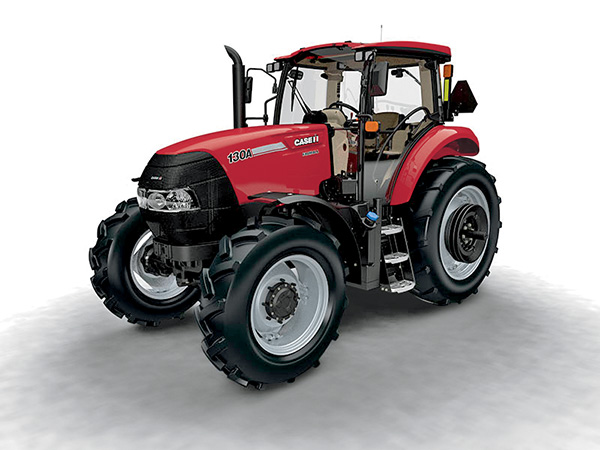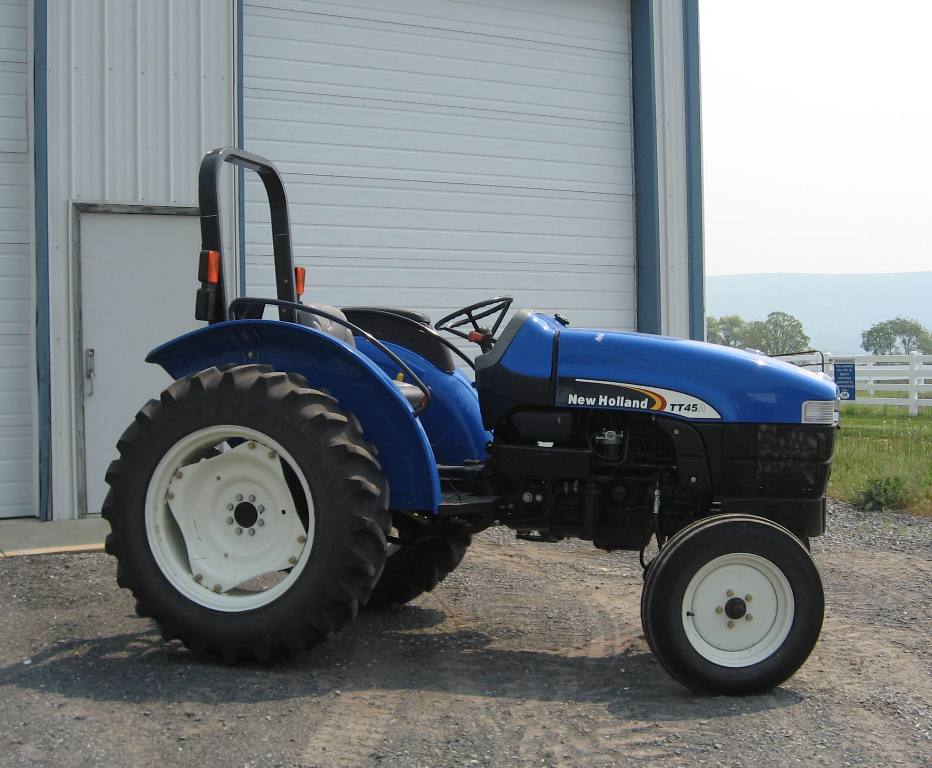
(Photo Source: Pennsylvania State University – Ag Safety and Health)
Use the following format to cite this article:
Tractor stability. (2014) Farm and Ranch eXtension in Safety and Health (FReSH) Community of Practice. Retrieved from http://articles.extension.org/pages/70338/tractor-stability.
The tractor is the most recognized piece of equipment on a farm or ranch, but it is also associated with incidents that can lead to serious injuries or death. There are various makes, models, and designs for tractors, but the basic components of tractor stability remain the same. By understanding tractor stability, you can reduce your potential for a tractor overturn incident.
Understanding Center of Gravity
The center of gravity for any object is the point on the object where all parts perfectly balance one another. For example, the point at which a pencil will balance on your finger is its center, and this center point is easily found by practicing balancing a pencil on the end of your finger. But finding the center point on larger objects is not always as simple. For example, the center of gravity on a two-wheel drive tractor is typically in the center of the tractor body as you look from right to left, but is about 10 inches above and 2 feet in front of the rear axle as you look from back to front. This center of gravity placement disperses the weight so that 30 percent of the tractor’s weight is on the front axle and 70 percent is on the rear axle.
The center of gravity must remain within the tractor’s stability baseline for the tractor to remain in an upright position. Stability baselines (shown below) are imaginary lines drawn between points where the tractor tires contact the ground.

(Photo Source: Canadian Centre for Occupational Health and Safety)
Compared to an automobile, the center of gravity is higher on a tractor because the tractor needs to be higher in order to complete operations over crops and rough terrain. Terrains, attachments, weights, and speeds can change the tractor’s resistance to turning over. The following examples describe situations in which the stability of a tractor can change:
- Whenever mounted equipment is raised, the center of gravity is also raised, decreasing tractor stability.
- Any changes in weight from an attachment—such as a front-end loader, bale fork, and so on—or load can shift the center of gravity toward the weight.
- Implements that are side mounted shift the center of gravity toward the attachment.
Tractor Stability
In addition to the center of gravity, other factors important to tractor stability include centrifugal force, rear-axle torque, and drawbar leverage.
Centrifugal Force
Centrifugal force is the outward force of objects moving in a circular path. In regards to a tractor, centrifugal force is the force that is trying to roll the tractor over when it is making a turn. As the radius of the turn decreases (in a sharp turn) the centrifugal force increases. There is a relationship between centrifugal force and speed, but it is not directly proportional (for example, when the tractor speed is tripled from 3 mph to 9 mph, the centrifugal force increases 9 times). Since centrifugal force increases when turning, it is often a factor in a side overturn. The effect of this centrifugal force on stability is even greater when operating a tractor on sloped terrain.
Rear-Axle Torque
Rear-axle torque is the transfer of energy between the engine and the rear axle of a two-wheel drive tractor. When the clutch is engaged on this type of tractor, it results in a twisting force, or torque, which should rotate the tires and move the tractor forward or backward. If the rear tires are stuck (as in mud) or blocked from rotating, the rear axle is unable to rotate properly, so the tractor chassis rotates about the axle. This results in the front end of the tractor lifting off the ground, which can cause the tractor’s center of gravity to move past the rear stability baseline. This type of incident is called a rear overturn, and the “point of no return” (shown below) can occur in less than a second, which is not enough time for the operator to react and try to stop the rearward motion. A rear overturn incident with a four-wheel drive tractor can occur, but it occurs less frequently than with a two-wheel drive tractor because more weight is carried on the front axle, and the center of gravity is closer to the front of the tractor. By design, the front tires of four-wheel drive or front-wheel assist tractors have more traction and will not rise off the ground as easily as the wheels of a tractor with two-wheel drive.
(Image Source:Safety Management for Landscapers, Grounds-care Business, and Golf Courses, John Deere Publishing, 2001. Illustration reproduced by permission. All rights reserved)
Drawbar Leverage
Drawbar leverage is another stability factor in a rear overturn incident. When a two-wheel drive tractor is pulling a load, there is a backward and downward pull that causes the rear tires to become a pivot point. An “angle of pull” is created between the ground’s surface and the attachment point on the tractor that acts as a force to tip the tractor rearward. The drawbar on a tractor is designed to counteract the rearward tipping potential of pulled loads; however, when a load is attached to the tractor at any point other than the drawbar, the drawbar design is no longer effective in preventing rear overturn incidents.
Tractors are commonly used to pull stumps out of the ground. A tractor is hitched safely when the log chain is wrapped around the tree stump and attached to the tractor drawbar. The log chain is properly attached to the tractor drawbar, providing a lower “angle of pull” and decreasing the leverage necessary to tip a tractor rearward. Unsafe hitching occurs when the load is attached to a point other than the drawbar. If the log chain is attached to the rear axle instead of the drawbar, the “angle of pull” and leverage do not decrease as the tractor’s front end rises. When hitching to something that is higher than the drawbar hitch point, such as the rear axle, there is increased pressure on the rear tires. This might prevent the tractor tires from slipping and cause the front end to lift. Click here to view videos of tractor stability and tractor overturn incident demonstrations.
Use the following format to cite this article:
Tractor stability. (2014) Farm and Ranch eXtension in Safety and Health (FReSH) Community of Practice. Retrieved from http://articles.extension.org/pages/70338/tractor-stability.
Sources
How can you maintain stability on various gradients? (2002) Canadian Centre for Occupational Health and Safety. Retrieved from http://www.ccohs.ca/oshanswers/safety_haz/tractors/stability.html.
Murphy, D. (2014) Tractor overturn hazards. Penn State College of Agricultural Sciences, Cooperative Extension. Retrieved from http://extension.psu.edu/business/ag-safety/vehicles-and-machinery/tract….
Tractor stability (2012) Canadian Centre for Occupational Health and Safety. Retrieved from http://www.ccohs.ca/oshanswers/safety_haz/tractors/stability.html.


